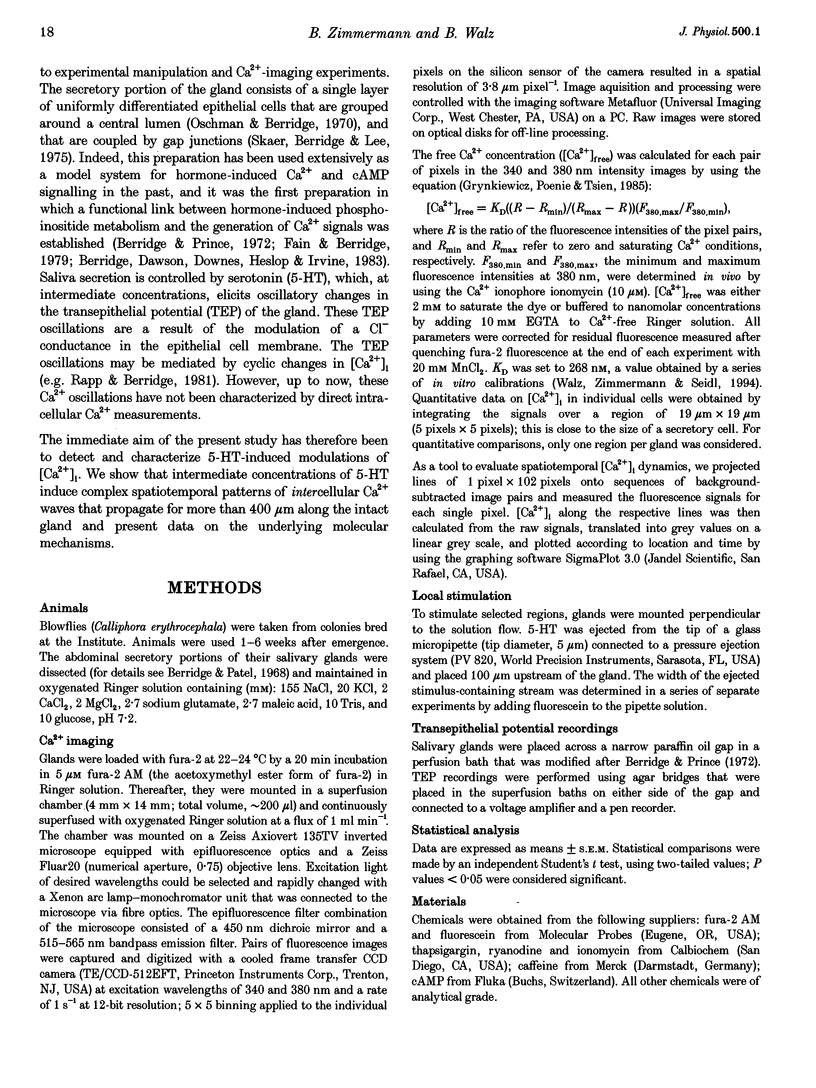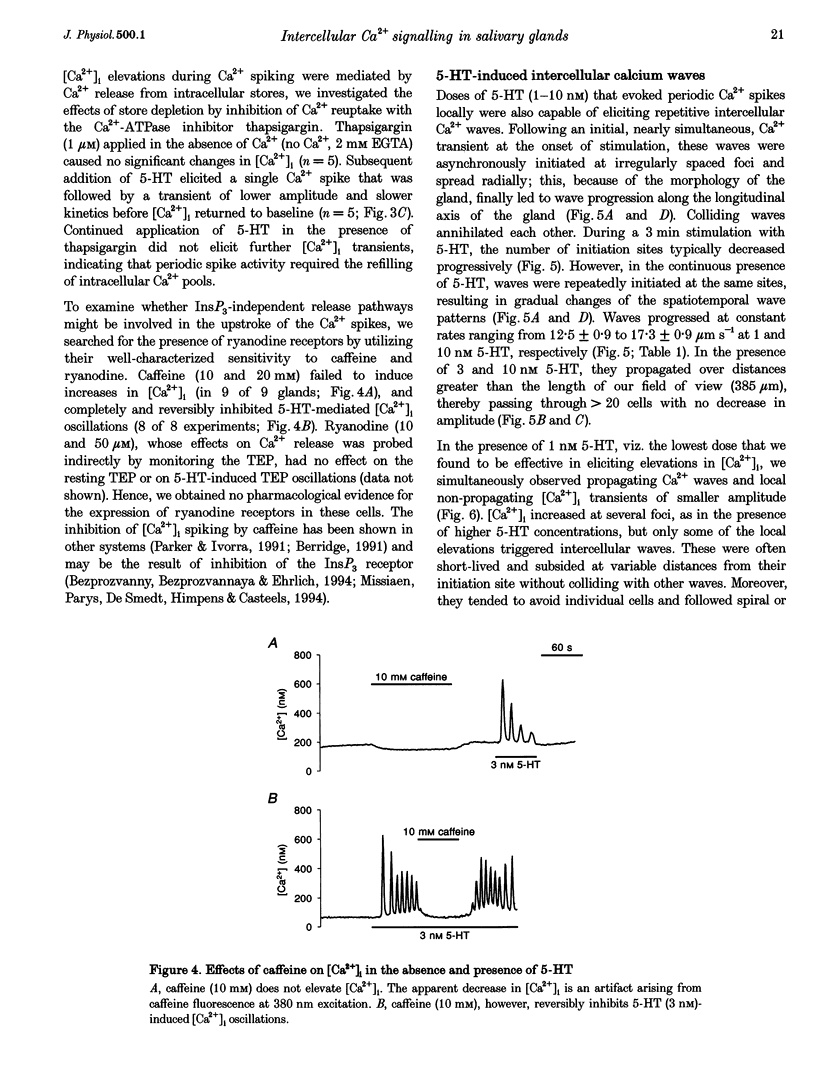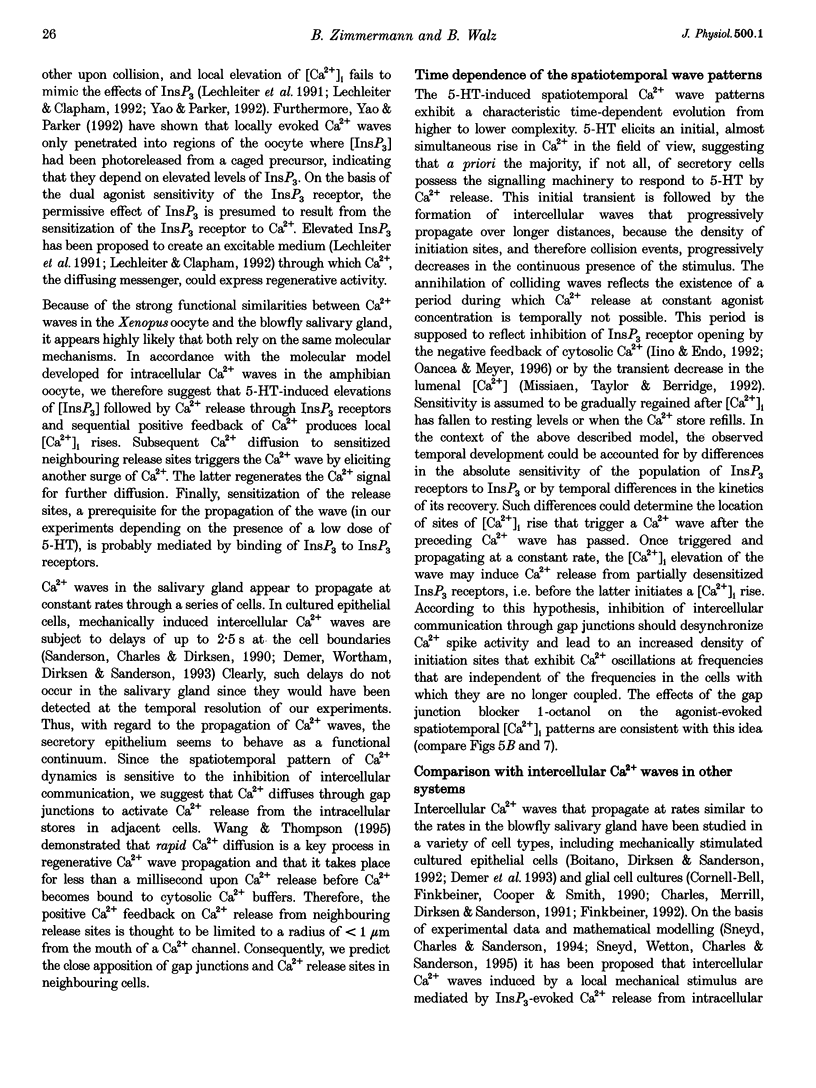Abstract
1. Blowfly salivary glands have been used extensively as a model system for the analysis of inositol phosphate-dependent signal transduction. To detect and characterize changes in intracellular free calcium ([Ca2+]i) that might be expected to be triggered by stimulation with serotonin (5-HT), we have carried out digital calcium-imaging experiments on intact glands using the Ca2+-sensitive dye fura-2. 2. 5-HT (1-10 nM) induced repetitive transient increases in [Ca2+]i, i.e. Ca2+ spikes whose frequency was a function of agonist concentration (EC50 = 2.8 nM). 3. Pre-incubation in EGTA decreased the frequency but did not inhibit spiking. Thapsigargin abolished periodic spike activity indicating that the [Ca2+]i rise results from Ca2+ release. Neither caffeine (10 mM) nor ryanodine (10 and 50 microM) induced increases in [Ca2+]i. 4. Oscillatory activity in individual cells was synchronized by regenerative intercellular Ca2+ waves that propagated over distances greater than 400 microm. Colliding waves annihilated each other. 5. Desynchronization of the oscillation pattern by 100 microM 1-octanol suggests the involvement of gap junctions and an intracellular messenger in wave propagation. 6. Local stimulation of glands elicited [Ca2+]i elevations in the stimulated area, but not in adjacent cells, indicating that local increases in [Ca2+]i are not sufficient to trigger Ca2+ waves. However, local stimulation was capable of evoking propagating Ca2+ waves when combined with low-dose 5-HT stimulation of the whole gland. 7. The data are consistent with the hypothesis that: (1) Ca2+ acts as the intercellular messenger and modulates its own release via positive and negative feedback on the inosital 1,4,5-trisphosphate (InsP3) receptor, and (2) sensitization of the InsP3 receptor to Ca2+ by InsP3 is required for the propagation of intercellular Ca2+ waves, as proposed for intracellular Ca2+ waves in Xenopus oocytes.
Full text
PDF











Images in this article
Selected References
These references are in PubMed. This may not be the complete list of references from this article.
- Atri A., Amundson J., Clapham D., Sneyd J. A single-pool model for intracellular calcium oscillations and waves in the Xenopus laevis oocyte. Biophys J. 1993 Oct;65(4):1727–1739. doi: 10.1016/S0006-3495(93)81191-3. [DOI] [PMC free article] [PubMed] [Google Scholar]
- Berridge M. J. Caffeine inhibits inositol-trisphosphate-induced membrane potential oscillations in Xenopus oocytes. Proc Biol Sci. 1991 Apr 22;244(1309):57–62. doi: 10.1098/rspb.1991.0051. [DOI] [PubMed] [Google Scholar]
- Berridge M. J., Dawson R. M., Downes C. P., Heslop J. P., Irvine R. F. Changes in the levels of inositol phosphates after agonist-dependent hydrolysis of membrane phosphoinositides. Biochem J. 1983 May 15;212(2):473–482. doi: 10.1042/bj2120473. [DOI] [PMC free article] [PubMed] [Google Scholar]
- Berridge M. J. Inositol trisphosphate and calcium signalling. Nature. 1993 Jan 28;361(6410):315–325. doi: 10.1038/361315a0. [DOI] [PubMed] [Google Scholar]
- Berridge M. J., Lindley B. D., Prince W. T. Membrane permeability changes during stimulation of isolated salivary glands of Calliphora by 5-hydroxytryptamine. J Physiol. 1975 Jan;244(3):549–567. doi: 10.1113/jphysiol.1975.sp010812. [DOI] [PMC free article] [PubMed] [Google Scholar]
- Berridge M. J., Patel N. G. Insect salivary glands: stimulation of fluid secretion by 5-hydroxytryptamine and adenosine-3',5'-monophosphate. Science. 1968 Oct 25;162(3852):462–463. doi: 10.1126/science.162.3852.462. [DOI] [PubMed] [Google Scholar]
- Berridge M. J., Prince W. T. Transepithelial potential changes during stimulation of isolated salivary glands with 5-hydroxytryptamine and cyclic AMP. J Exp Biol. 1972 Feb;56(1):139–153. doi: 10.1242/jeb.56.1.139. [DOI] [PubMed] [Google Scholar]
- Bezprozvanny I., Bezprozvannaya S., Ehrlich B. E. Caffeine-induced inhibition of inositol(1,4,5)-trisphosphate-gated calcium channels from cerebellum. Mol Biol Cell. 1994 Jan;5(1):97–103. doi: 10.1091/mbc.5.1.97. [DOI] [PMC free article] [PubMed] [Google Scholar]
- Bezprozvanny I., Watras J., Ehrlich B. E. Bell-shaped calcium-response curves of Ins(1,4,5)P3- and calcium-gated channels from endoplasmic reticulum of cerebellum. Nature. 1991 Jun 27;351(6329):751–754. doi: 10.1038/351751a0. [DOI] [PubMed] [Google Scholar]
- Boitano S., Dirksen E. R., Sanderson M. J. Intercellular propagation of calcium waves mediated by inositol trisphosphate. Science. 1992 Oct 9;258(5080):292–295. doi: 10.1126/science.1411526. [DOI] [PubMed] [Google Scholar]
- Charles A. C., Merrill J. E., Dirksen E. R., Sanderson M. J. Intercellular signaling in glial cells: calcium waves and oscillations in response to mechanical stimulation and glutamate. Neuron. 1991 Jun;6(6):983–992. doi: 10.1016/0896-6273(91)90238-u. [DOI] [PubMed] [Google Scholar]
- Fain J. N., Berridge M. J. Relationship between hormonal activation of phosphatidylinositol hydrolysis, fluid secretion and calcium flux in the blowfly salivary gland. Biochem J. 1979 Jan 15;178(1):45–58. doi: 10.1042/bj1780045. [DOI] [PMC free article] [PubMed] [Google Scholar]
- Fewtrell C. Ca2+ oscillations in non-excitable cells. Annu Rev Physiol. 1993;55:427–454. doi: 10.1146/annurev.ph.55.030193.002235. [DOI] [PubMed] [Google Scholar]
- Finkbeiner S. Calcium waves in astrocytes-filling in the gaps. Neuron. 1992 Jun;8(6):1101–1108. doi: 10.1016/0896-6273(92)90131-v. [DOI] [PubMed] [Google Scholar]
- Grynkiewicz G., Poenie M., Tsien R. Y. A new generation of Ca2+ indicators with greatly improved fluorescence properties. J Biol Chem. 1985 Mar 25;260(6):3440–3450. [PubMed] [Google Scholar]
- Heslop J. P., Berridge M. J. Changes in cyclic AMP and cyclic GMP concentrations during the action of 5-hydroxytryptamine on an insect salivary gland. Biochem J. 1980 Oct 15;192(1):247–255. doi: 10.1042/bj1920247. [DOI] [PMC free article] [PubMed] [Google Scholar]
- Iino M., Endo M. Calcium-dependent immediate feedback control of inositol 1,4,5-triphosphate-induced Ca2+ release. Nature. 1992 Nov 5;360(6399):76–78. doi: 10.1038/360076a0. [DOI] [PubMed] [Google Scholar]
- Lechleiter J. D., Clapham D. E. Molecular mechanisms of intracellular calcium excitability in X. laevis oocytes. Cell. 1992 Apr 17;69(2):283–294. doi: 10.1016/0092-8674(92)90409-6. [DOI] [PubMed] [Google Scholar]
- Lechleiter J., Girard S., Peralta E., Clapham D. Spiral calcium wave propagation and annihilation in Xenopus laevis oocytes. Science. 1991 Apr 5;252(5002):123–126. doi: 10.1126/science.2011747. [DOI] [PubMed] [Google Scholar]
- Missiaen L., Parys J. B., De Smedt H., Himpens B., Casteels R. Inhibition of inositol trisphosphate-induced calcium release by caffeine is prevented by ATP. Biochem J. 1994 May 15;300(Pt 1):81–84. doi: 10.1042/bj3000081. [DOI] [PMC free article] [PubMed] [Google Scholar]
- Missiaen L., Taylor C. W., Berridge M. J. Luminal Ca2+ promoting spontaneous Ca2+ release from inositol trisphosphate-sensitive stores in rat hepatocytes. J Physiol. 1992 Sep;455:623–640. doi: 10.1113/jphysiol.1992.sp019319. [DOI] [PMC free article] [PubMed] [Google Scholar]
- Oancea E., Meyer T. Reversible desensitization of inositol trisphosphate-induced calcium release provides a mechanism for repetitive calcium spikes. J Biol Chem. 1996 Jul 19;271(29):17253–17260. doi: 10.1074/jbc.271.29.17253. [DOI] [PubMed] [Google Scholar]
- Parker I., Ivorra I. Caffeine inhibits inositol trisphosphate-mediated liberation of intracellular calcium in Xenopus oocytes. J Physiol. 1991 Feb;433:229–240. doi: 10.1113/jphysiol.1991.sp018423. [DOI] [PMC free article] [PubMed] [Google Scholar]
- Parker I., Ivorra I. Inhibition by Ca2+ of inositol trisphosphate-mediated Ca2+ liberation: a possible mechanism for oscillatory release of Ca2+. Proc Natl Acad Sci U S A. 1990 Jan;87(1):260–264. doi: 10.1073/pnas.87.1.260. [DOI] [PMC free article] [PubMed] [Google Scholar]
- Robb-Gaspers L. D., Thomas A. P. Coordination of Ca2+ signaling by intercellular propagation of Ca2+ waves in the intact liver. J Biol Chem. 1995 Apr 7;270(14):8102–8107. doi: 10.1074/jbc.270.14.8102. [DOI] [PubMed] [Google Scholar]
- Sanderson M. J., Charles A. C., Boitano S., Dirksen E. R. Mechanisms and function of intercellular calcium signaling. Mol Cell Endocrinol. 1994 Jan;98(2):173–187. doi: 10.1016/0303-7207(94)90136-8. [DOI] [PubMed] [Google Scholar]
- Sanderson M. J., Charles A. C., Dirksen E. R. Mechanical stimulation and intercellular communication increases intracellular Ca2+ in epithelial cells. Cell Regul. 1990 Jul;1(8):585–596. doi: 10.1091/mbc.1.8.585. [DOI] [PMC free article] [PubMed] [Google Scholar]
- Skaer H. B., Berridge M. J., Lee W. M. A freeze-fracture study of adult Calliphora salivary glands. Tissue Cell. 1975;7(4):677–688. doi: 10.1016/0040-8166(75)90036-1. [DOI] [PubMed] [Google Scholar]
- Sneyd J., Charles A. C., Sanderson M. J. A model for the propagation of intercellular calcium waves. Am J Physiol. 1994 Jan;266(1 Pt 1):C293–C302. doi: 10.1152/ajpcell.1994.266.1.C293. [DOI] [PubMed] [Google Scholar]
- Sneyd J., Wetton B. T., Charles A. C., Sanderson M. J. Intercellular calcium waves mediated by diffusion of inositol trisphosphate: a two-dimensional model. Am J Physiol. 1995 Jun;268(6 Pt 1):C1537–C1545. doi: 10.1152/ajpcell.1995.268.6.C1537. [DOI] [PubMed] [Google Scholar]
- Wakui M., Petersen O. H. Cytoplasmic Ca2+ oscillations evoked by acetylcholine or intracellular infusion of inositol trisphosphate or Ca2+ can be inhibited by internal Ca2+. FEBS Lett. 1990 Apr 24;263(2):206–208. doi: 10.1016/0014-5793(90)81374-w. [DOI] [PubMed] [Google Scholar]
- Yao Y., Parker I. Potentiation of inositol trisphosphate-induced Ca2+ mobilization in Xenopus oocytes by cytosolic Ca2+. J Physiol. 1992 Dec;458:319–338. doi: 10.1113/jphysiol.1992.sp019420. [DOI] [PMC free article] [PubMed] [Google Scholar]






